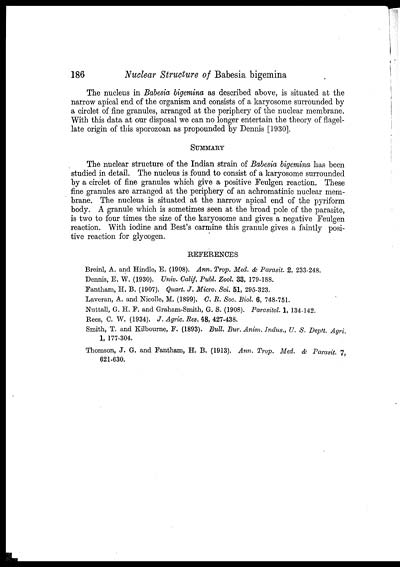Medicine - Veterinary > Veterinary colleges and laboratories > Indian journal of veterinary science and animal husbandry > Volume 8, 1938 > Original articles > On the nuclear structure of Babesia bigemina (Smith and Kilbourne)
(204) Page 186
Download files
Individual page:
Thumbnail gallery: Grid view | List view

186 Nuclear Structure of Babesia bigemina
The nucleus in Babesia bigemina as described above, is situated at the
narrow apical end of the organism and consists of a karyosome surrounded by
a circlet of fine granules, arranged at the periphery of the nuclear membrane.
With this data at our disposal we can no longer entertain the theory of flagel-
late origin of this sporozoan as propounded by Dennis [1930].
SUMMARY
The nuclear structure of the Indian strain of Babesia bigemina has been
studied in detail. The nucleus is found to consist of a karyosome surrounded
by a circlet of fine granules which give a positive Feulgen reaction. These
fine granules are arranged at the periphery of an achromatinic nuclear mem-
brane. The nucleus is situated at the narrow apical end of the pyriform
body. A granule which is sometimes seen at the broad pole of the parasite,
is two to four times the size of the karyosome and gives a negative Feulgen
reaction. With iodine and Best's carmine this granule gives a faintly posi-
tive reaction for glycogen.
REFERENCES
Breinl, A. and Hindle, E. (1908). Ann. Trop. Med. & Parasit. 2, 233-248.
Dennis, E. W. (1930). Univ. Calif. Publ. Zool. 33, 179-188.
Fantham, H. B. (1907). Quart. J. Micro. Sci. 51, 295-323.
Laveran, A. and Nicolle, M. (1899). C. R. Soc. Biol. 6, 748-751.
Nuttall, G. H. F. and Graham-Smith, G. S. (1908). Parasitol. 1, 134-142.
Rees, C. W. (1934). J. Agric. Res. 48, 427-438.
Smith, T. and Kilbourne, F. (1893). Bull. Bur. Anim. Indus., U. S. Deptt. Agri.
1, 177-304.
Thomson, J. G. and Fantham, H. B. (1913). Ann. Trop. Med. & Parasit. 7,
621-630.
Set display mode to: Large image | Zoom image | Transcription
Images and transcriptions on this page, including medium image downloads, may be used under the Creative Commons Attribution 4.0 International Licence unless otherwise stated. ![]()
| Permanent URL | https://digital.nls.uk/75244120 |
|---|
| Description | Covers articles from 1938. |
|---|




